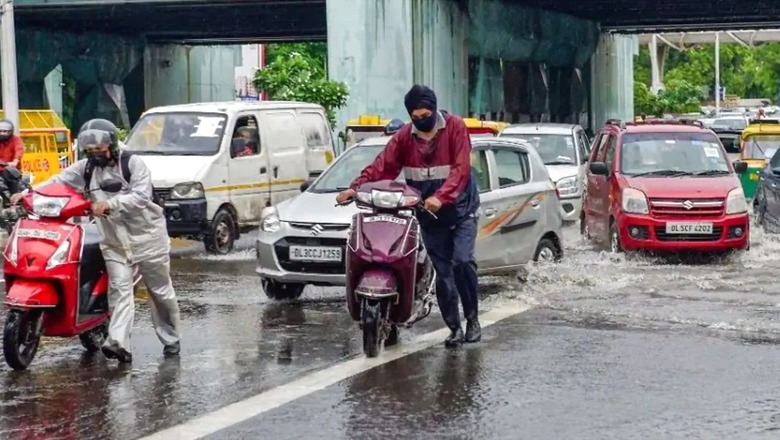
views
Unusual yet heavy rains delayed flights and disrupted traffic in New Delhi on Saturday, inundating several places including the forecourt of Indira Gandhi International Airport. A highly unusual monsoon season this year has yielded 1,100 mm of rainfall in Delhi so far, the highest in 46 years, and almost double the precipitation recorded last year, the India Meteorological Department (IMD) said on Saturday. The figures are subject to change as more rainfall is predicted in the city during the day.
This year, Delhi has recorded unusual rains in September, summer rains during may and an unusual dry summer this year. The country has also received erratic monsoon this year, with August seeing poor rain.
Unusual September
According to the Safdarjung Observatory, which is considered the official marker for the city, this year, the precipitation has already hit the 1,100-mm mark and the season has not ended yet. Normally, Delhi records 648.9 mm of rainfall during the monsoon season. The highest rainfall during this period was earlier recorded at 1,150 mm in the 1975 monsoon season.
Between June 1, when the monsoon season starts, and September 11, the city normally gets 590.2 mm of rainfall. The monsoon withdraws from Delhi by September 25.
It has been a bountiful September for Delhi, with 343.6 mm of rainfall recorded so far this month, which is the highest in at least 12 years, according to data available on the IMD’s website. The September rainfall this year has been in marked contrast to the last year, when the city got a meagre 20.9 mm precipitation in the month against the normal of 129.8 mm.
Foggy February
Delhi and parts of western Uttar Pradesh saw an unusually dense cover of fog in the morning and evening hours in February this year. The temperatures have remained higher than normal while the morning and evening hours witnessed dense fog. Scientists said that such dense fog over Delhi in the latter part of February was “never seen before”.
RK Jenamani, senior scientist at the National Weather Forecasting Centre told Hindustan Times that dense fog over Delhi in February have been recorded before, but only for two or three days, and that too in the first week of February. However, this time the fog spell has occurred even when the night time temperature was 2-3 degrees above normal and that is unique.
Summer Rains in May
Earlier in May 20 this year, Delhi witnessed a drastic change with record rainfall, the highest single-day rain since 1976. Weather experts say that it is an after effect of Cyclone Tauktae, one of the strongest cyclones to have been recorded in the Arabian Sea. Post its landfall in Gujarat, it weakened and its remnants moved in the north-northeast direction from the western coast towards Delhi. Following this event, a western disturbance has been reported in Jammu and Kashmir.
This disturbance has affected the Union territory, Ladakh and their adjoining areas, bringing isolated snow/rain and thunderstorms this weekend and into the next week. The phenomenon is also impacting other states in north India.
Heatwave During Monsoon
The maximum temperature recorded in the national capital on June 30 this year was 43.73 degrees Celsius. This is the second highest maximum temperature on this day since 1951, less than a tenth of a degree lower than the 43.76 degrees Celsius recorded on June 30, 1987, a report in Hindustan Times said.
Delhi was experiencing a heatwave in June end when ideally it should have been raining indicating the unusual turns in Delhi’s weather. It added that June 30 this year was the hottest day in Delhi this summer, something which has never happened since 1951. Earlier the hottest days have been mostly before June 12.
Dry Monsoons
The period between June 1 and September 30 is officially considered to be the monsoon in India. According to IMD’s database, Delhi’s cumulative monsoon rainfall as of 8.30am on June 30 was 23.32mm, 61% lower than long period average (LPA).
The report also showed that rainfall has been deficient in June. Against an LPA of 44.7mm rainfall from June 16 to June 30, this year’s rainfall is just 6mm or 87% deficient, making it the 22nd highest rainfall deficit since 1901.
Read all minute-by-minute news updates for Uttar Pradesh election results 2022, Punjab election results 2022, Uttarakhand election results 2022, Manipur election results 2022, and Goa election results 2022.
Click here for seat-wise LIVE result updates.
















Comments
0 comment